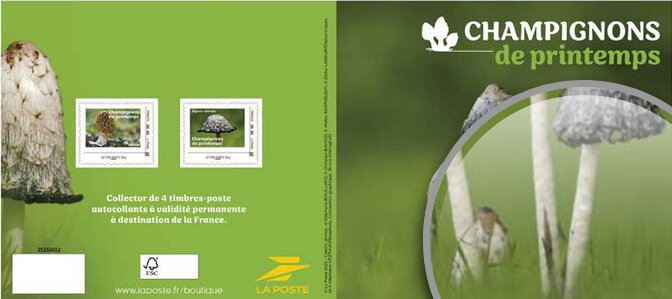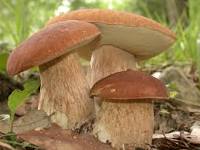Mini Sheet: Mushrooms of Spring (France 2025)
Mushrooms of Spring (France 2025)
01 April (France ) within release Collector : Mushrooms of Spring goes into circulation Mini Sheet Mushrooms of Spring face value 4*LettreVerte20 No Face Value
| Mini Sheet Mushrooms of Spring in catalogues | |
|---|---|
| Colnect codes: | Col: FR-COLL 2025-09 |
Mini Sheet is square format.
Also in the issue Collector : Mushrooms of Spring:
- Stamp - Coprin chevelu face value Lettre;
- Stamp - Morille face value Lettre;
- Mini Sheet - Mushrooms of Spring face value 4*LettreVerte20;
Mini Sheet Mushrooms of Spring it reflects the thematic directions:
A mushroom (or toadstool) is the fleshy, spore-bearing fruiting body of a fungus, typically produced above ground on soil or on its food source. The standard for the name "mushroom" is the cultivated white button mushroom, Agaricus bisporus; hence the word "mushroom" is most often applied to those fungi (Basidiomycota, Agaricomycetes) that have a stem (stipe), a cap (pileus), and gills (lamellae, sing. lamella) on the underside of the cap. These gills produce microscopic spores that help the fungus spread across the ground or its occupant surface. "Mushroom" describes a variety of gilled fungi, with or without stems, and the term is used even more generally, to describe both the fleshy fruiting bodies of some Ascomycota and the woody or leathery fruiting bodies of some Basidiomycota, depending upon the context of the word. Forms deviating from the standard morphology usually have more specific names, such as "bolete", "puffball", "stinkhorn", and "morel", and gilled mushrooms themselves are often called "agarics" in reference to their similarity to Agaricus or their order Agaricales. By extension, the term "mushroom" can also designate the entire fungus when in culture; the thallus (called a mycelium) of species forming the fruiting bodies called mushrooms; or the species itself.
Spring, also known as springtime, is one of the four temperate seasons, succeeding winter and preceding summer. There are various technical definitions of spring, but local usage of the term varies according to local climate, cultures and customs. When it is spring in the Northern Hemisphere, it is autumn in the Southern Hemisphere and vice versa. At the spring (or vernal) equinox, days and nights are approximately twelve hours long, with daytime length increasing and nighttime length decreasing as the season progresses until the Summer Solstice in June (Northern Hemisphere) and December (Southern Hemisphere).


